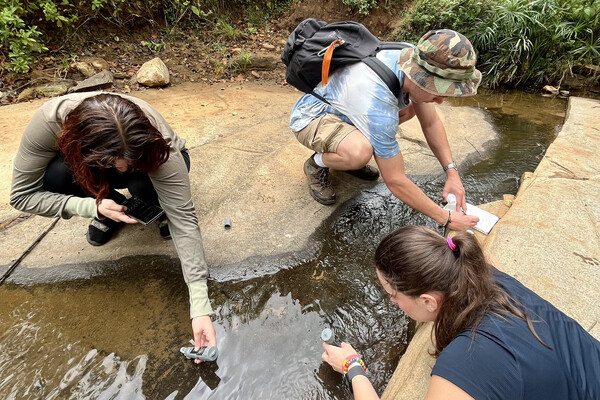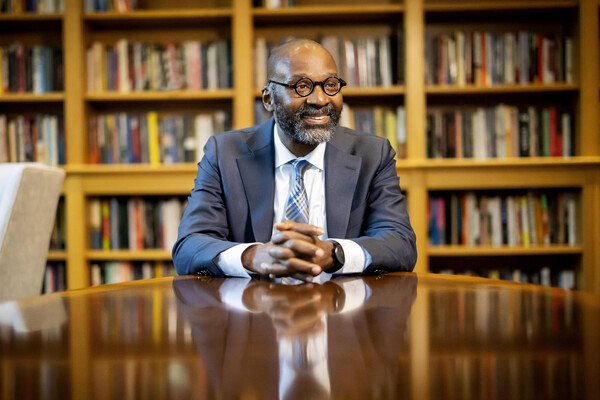
Griffin Pitt, right, works with two other student researchers to test the conductivity, total dissolved solids, salinity, and temperature of water below a sand dam in Kenya.
(Image: Courtesy of Griffin Pitt)
Three decades ago, Kathleen Hall Jamieson was named dean of Penn’s Annenberg School for Communication. It was a position the flourishing scholar, author, and professor was ready and willing to take on—but she had one other aspiration: She wanted to direct a policy center.
In 1993, thanks to a special endowment from prominent philanthropists Walter and Leonore Annenberg, Jamieson got her wish.
Fast forward 25 years, and it’s hard to imagine a time when the University was without its Annenberg Public Policy Center (APPC). It’s regarded today as a home for producing research and reports about adolescent health and risk, improving civics education, and investigating how scientific evidence can be more effectively conveyed to the public—on a local, state, and federal level.
Perhaps the most recognized project initiated by APPC is its award-winning FactCheck.org, the oldest standalone political fact-checking organization, created 15 years ago. Today, the pioneering site, which sorts truth from spin in politics, reaches millions of readers, and has been joined by other fact-checking establishments, including PolitiFact.
“I’ve always been interested in using communication to increase public understanding,” says Jamieson, “and using communication to increase public well-being.”
Jamieson completed her term as the Annenberg School’s dean in 2003, but remains director of APPC to this day. Her office there is dressed with furnishings given to the Center by the Annenbergs, including the 1790 partner’s desk originally purchased by Walter Annenberg for his office when serving from 1969-74 as President Richard Nixon’s ambassador to the United Kingdom.
At the heart of campus, Jamieson’s tall windows overlook 36th Street, right between Walnut Street and Locust Walk. The APPC building, completed in 2009, is located next to the Annenberg School, which Walter Annenberg established at the University in 1958.
As she’s finishing up a phone interview with a national newspaper—typical for Jamieson—she takes a seat in one of the two chairs placed in front of her desk. She speaks passionately about APPC’s creation, and excitedly about its evolution.
“Because Penn didn’t have a policy center,” Jamieson says, “it wasn’t getting some of the kinds of synergies its excellent departments and schools could produce.”
Even without a dedicated space in the 1990s, APPC was gaining its footing, and slowly growing its reputation. Some of its first works focused on identifying, through studies, what the public knew about civics, and trying to increase the quality of civics materials in middle and high schools.
A special endowment from Leonore Annenberg established APPC’s Leonore Annenberg Institute for Civics, which gave momentum to push forward several projects, including Student Voices, which brought political candidates directly into city high schools to talk with students, and the radio program Justice Talking, which encouraged dialogue about the law and Constitution. Annenberg Classroom was formed, which offers, in partnership with the Annenberg Foundation Trust at Sunnylands, a curriculum of online videos and games on the Constitution. Also created by APPC was the Civics Renewal Network, a consortium of nonpartisan, nonprofit organizations that offer no-cost civics learning materials for teachers. Later, Pennsylvania Gov. Ed Rendell and Judge Marjorie Rendell allied their Rendell Institute for Civics and Civic Engagement with APPC’s Institute for Civics, creating a complementary component on civics education for elementary school students.
I’ve always been interested in using communication to increase public understanding, and using communication to increase public well-being.
Kathleen Hall Jamieson, Director, Annenberg Public Policy Center
APPC’s civics charge becomes especially significant when it releases, every fall for Constitution Day, a civics knowledge survey. In fact, the 2016 survey that showed that only 26 percent of adults could identify the three branches of the U.S. government spurred talks at the state level to incorporate a civics test as a requirement for high school graduation. The civics surveys were also cited last month in a bipartisan bill proposed in Congress, the Civics Learning Act, which seeks to “increase civics education programs,” because “the dearth of civics lessons available to students across the United States has helped to foster a political climate that is deeply partisan and divided.”
Another endeavor the APPC has always been interested in is documenting election effects, or, as Jamieson puts it, “the ways in which campaigns influence voters.”
She’s expressed much of this work through books, including co-authoring “The 2000 Presidential Election and the Foundations of Party Politics,” published in 2004; co-authoring “The Obama Victory,” published in 2010; and her latest, “Cyberwar,” which was published last year. The latter two both received a PROSE Award from the Association of American Publishers as the best books in the Government, Policy, and Politics category. Each book, detailing three separate elections, builds upon APPC research.
APPC has also addressed risks for young people’s health and development. Reflecting on some of his earliest work with APPC, Dan Romer, now the Center’s research director, recalls reports he did in the 1990s with colleagues that pinpointed how the tobacco industry was misleading about the dangers of its products, how online gambling could influence adolescents already obsessed with poker, and how journalists should cover suicides—an issue that was increasingly affecting teenagers.
“In partnership with other organizations, we put together recommendations on covering suicides for journalists that have stood the test of time,” Romer says. “Nowadays, journalists know that there are certain things you should and shouldn’t do if you report on a suicide, but when we started, they said, ‘What’s the problem?’ When we started, they didn’t recognize the possible impact of describing the method or romanticizing the death.”
Part of what makes APPC unique in its adolescent health and risk research area is its longstanding CHAMP/CHAMPION project, which has coded health risk portrayals in film and TV programs over more than a half-century. Supported by the Annenberg Foundation and the Robert Wood Johnson Foundation, the dataset provides evidence of how certain issues—such as gun violence and smoking, as well as “culture of health” variables like family eating and exercise, for instance—are portrayed in popular entertainment and how they affect behavior.
“The suicide guidelines are an example of something that could not have happened had we not done research to verify the prevalence of problematic coverage and its effects,” Jamieson says. “Based on that work we created an intervention to change news coverage and talked with Hollywood producers about decreasing problematic portrayals in film and television.”
APPC researchers have also guided journalists who cover other tough subjects, such as terroristic threats or mental health, and have conducted research spanning campaign finance, internet privacy, and finding ways to reduce youth smoking, drug abuse, and the spread of HIV. In 2014, APPC established a research arm specifically studying science communication, which has focused on topics such as Zika awareness, GMOs, and vaccinations, and provided a basis for “The Oxford Handbook of The Science of Science Communication,” published in 2017 and co-edited by Jamieson.
Today, one of APPC’s postdoctoral fellows, Elizabeth Walshe, is working alongside researchers from APPC and the Children’s Hospital of Philadelphia’s Center for Injury Research and Prevention to study the neuroscience of driving. She’s looking at the neural and cognitive factors that influence how well adolescents can drive.
“One of the things that really appealed to me is that sometimes when you are in cognitive neuroscience, or even science in general, it can be hard to see how your work might have an impact directly on people, in the immediate future,” Walshe says. “That’s why I was really inspired with the idea of working at a policy center.”
APPC has made its mark on the arts, too. The APPC’s Leonore Annenberg Arts Fellowship for the Performing and Visual Arts, which ran from 2008-2017, has awarded $7 million to 70 fellows in the performing and visual arts, including the likes of Misty Copeland, the American Ballet Theatre’s first African-American female principal dancer; bass-baritone Ryan Speedo Green; and actor André Holland of the TV series “The Knick” and film “Moonlight.”
“What you are seeing,” Jamieson explains, “is our theme of research and engagement that matter.”
Back in 1992, Jamieson published the book “Dirty Politics,” critiquing the 1988 presidential campaigns of President George W. Bush and Michael Dukakis. She focused on the inaccurate advertisements that the press was featuring in news without correction.
“The press wasn’t performing its role,” says Jamieson, “which is to hold those in power accountable and to ensure the public is protected from deception.”
Soon after her book came out, Jamieson, with the help of Annenberg School graduate students, developed a “visual grammar” for covering and fact checking ads in news, which networks, including CNN, began using. Brooks Jackson, a longtime political reporter who was at CNN at the time, happily leaned into the mission.
When Jackson left CNN, he was interested in teaching at a university.
“I figured I’d just tell war stories of my time as a reporter,” Jackson says, with a laugh. “And then when I ran out of stories I’d ask my journalist friends to come in and be a guest lecturer to tell their war stories.”
When Jackson called Jamieson, asking for guidance, she suggested he go a different route. In December 2003, FactCheck.org was born. The nonpartisan nonprofit, monitoring the factual accuracy of what is said by major U.S. political players, came just in time for the 2004 presidential election.
“I thought we were probably going to develop a small following of journalists and political junkies during the election, and there was a lot of that,” Jackson says. “But it became much more popular than either I or Kathleen anticipated.”
People are so susceptible to misinformation. And it can be difficult to be adequately informed. So we do the grunt work for people.
Chloe Wilson, a senior in the College of Arts and Sciences
It was actually Vice President Dick Cheney who put FactCheck.org on the map.
“I like to call him our marketer in chief,” says Jamieson. “He didn’t intend to be, but he was, and it didn’t cost us anything. Because of him, our scope and reach increased dramatically.”
Cheney, during a vice presidential debate, meant to reference the APPC’s fact-checking site, but accidentally used the domain name “FactCheck.com.” It turned out that the owner of that “.com” site wasn’t a fan of President H. W. Bush or Cheney, and sent visitors to a page in support of the running mates’ opponents. The news stories that ensued, detailing the quirky debacle, is what ultimately sent readers to the real FactCheck.org, Jackson presumes.
“We got so much unexpected traffic, our site crashed,” Jackson says. “The clock stopped at 400,000 unique visits that day. We had to very quickly reengineer the whole website.”
The rest of the election? Although it gives him angst, Jackson remembers it quite clearly: “It was like trying to change engines on an airplane while you were still flying it. We got through somehow, with 200,000 and 300,000 visits every day throughout the rest of that election,” he says.
As misinformation continued to spiral, because of advances in technology and the internet, FactCheck.org kept growing. In 2007, Jackson and Jamieson authored “unSpun: Finding Facts in a World of Disinformation,” teaching readers how to identify and debunk spin, hype, and fake news.

In its formative years, FactCheck.org was run out of the National Press Club building in Washington, D.C., but it moved to Penn’s campus in 2010 when the APPC’s new building was constructed, thanks to a $41.5 million gift from the Annenberg Foundation and the Annenberg Foundation Trust at Sunnylands. Jackson hired journalist Eugene Kiely as Philadelphia director of FactCheck.org and when Jackson decided to become director emeritus, following the 2012 election, Kiely succeeded him as director.
Kiely, formerly an editor at USA Today and The Philadelphia Inquirer, has made it his mission to scale the organization’s reach by forming partnerships with other media organizations, which often run FactCheck.org’s stories in full on their sites.
“Our copyright policy is ‘steal our stuff,’” Kiely says. “We are filling a need for news organizations, because they either don’t have the resources to do it or don’t have the time to do it. They are so time-pressed to move onto the next issue.”
Presidential elections are unsurprisingly the busiest time for FactCheck.org. Kiely recalls the 2016 election like it was yesterday: “We never stopped working,” he says. “But it was great. I loved it.”
Kiely says, on debate nights, he and his team would work until the early morning, to make sure they could have a story written before daybreak.
“The point was that we then got it out to a media distribution list for first thing in the morning,” he says. “That’s how we’d get the word out.”
He’d go to sleep for a few hours, then get up and start working on short videos on debate claims for FactCheck.org’s website.
“One of the things Kathleen and her research has found is that videos are more effective than text when doing fact checking,” Kiely says. “So we wanted to make sure we were reaching people in all different forms.”
FactCheck.org has also implemented a weekly fact checking feature done in partnership with CNN’s Jake Tapper, and an impressive partnership with Facebook—debunking misinformation that circulates through the popular site. In 2015, a grant from the Stanton Foundation allowed FactCheck.org to initiate its SciCheck feature, focusing exclusively on false and misleading scientific claims that are made to influence public policy.
Thanks in part to donations from FactCheck.org readers, who have contributed on average about $120,000 a year in recent years, FactCheck.org is operating with the largest staff it has ever had. It consists of seven full-time and one part-time journalist. It also operates an undergraduate fellowship program, which is funded by the Stanton Foundation, for five students, including Chloe Wilson, a senior in the College of Arts and Sciences who’s studying philosophy, politics, and economics.
Wilson works about 10 hours per week at FactCheck.org, helping copy edit stories, answering emails from readers, pinpointing research topics, and occasionally writing her own stories for publication on the site. It’s a rewarding learning opportunity, and one she’s grateful for—especially since it “touches the lives of people outside of Penn in such a positive way,” she says.
“People are so susceptible to misinformation,” Wilson says. “And it can be difficult to be adequately informed. So we do the grunt work for people.”
After 25 years, there’s no doubting the impact APPC has had. Jamieson says its efforts will only continue to grow.
Forecasting that APPC will evolve, Jamieson says that a new research project to be announced this month will address viral deception and hate speech across the globe.
“APPC has leveraged its scholarly understanding of how communication works into forms of engagement that matter,” Jamieson says. As Walter Annenberg once put it, “Every human advancement or reversal can be understood through communication.”
With those words as a guide, that is what she and the policy center are going for.
“I anticipate that in the next quarter-century, the same policy center that created FactCheck.org and SciCheck will pioneer new ways to use communication to enhance national well-being,” Jamieson says.
Homepage photo: Kiely and Jamieson stroll through the APPC building, which is located in the heart of Penn’s campus, and is also home to the award-winning FactCheck.org.
Lauren Hertzler

Griffin Pitt, right, works with two other student researchers to test the conductivity, total dissolved solids, salinity, and temperature of water below a sand dam in Kenya.
(Image: Courtesy of Griffin Pitt)

Image: Andriy Onufriyenko via Getty Images

nocred

Provost John L. Jackson Jr.
nocred